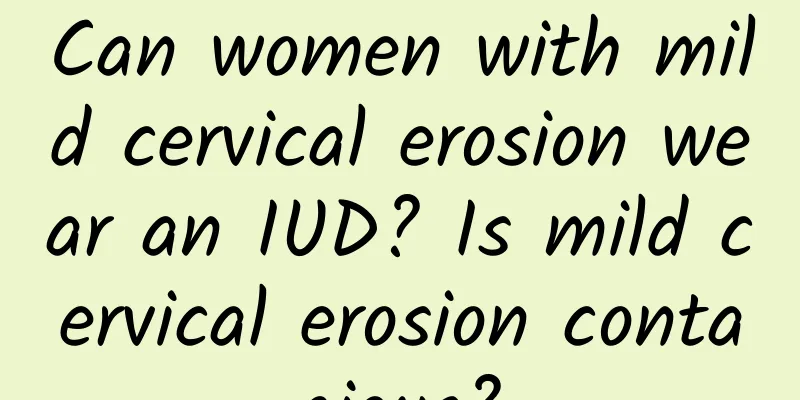Can women with mild cervical erosion wear an IUD? Is mild cervical erosion contagious?

|
Mild cervical erosion is not a very serious disease in the eyes of many people, because most women have some mild cervical erosion problems. So can women with mild cervical erosion wear an IUD? Is mild cervical erosion contagious? Let's take a look now! Can I wear an IUD if I have mild cervical erosion? Cervical erosion has a great impact on women's health. In order to reduce the incidence of cervical erosion, women should not only do regular check-ups and thorough treatment, but also control their sexual life, avoid artificial abortion, prohibit extramarital sex, and prevent sexually transmitted diseases. Cervical erosion should be treated as soon as possible after it is discovered, and not until it becomes serious. Since IUD insertion will aggravate inflammation and mild cervical erosion is easier to treat, it is better to treat it first and then insert the IUD. Many women think that mild cervical erosion is not a serious disease and it does not matter whether it is treated or not. In fact, cervical erosion must be treated in time. Failure to treat cervical erosion in time will seriously affect women's physical and mental health. Patients with mild cervical erosion will experience symptoms such as increased leucorrhea, light yellow, purulent or odorous, which seriously affects women's life and work. If not treated promptly and effectively, the condition will develop into moderate cervical erosion and severe cervical erosion, causing greater harm. If moderate and severe cervical erosion are not treated promptly, it can cause a variety of complications, and even infertility, cancer, etc. Is mild cervical erosion contagious? No, but cervical erosion can be divided into mild cervical erosion, moderate cervical erosion and severe cervical erosion according to the size of the erosion area. The specific manifestation of cervical erosion is a fine granular red area in the cervical vaginal part at the external os of the cervix. The boundary of the eroded surface is clearly demarcated from the normal cervical epithelium. It has now been renamed "cervical columnar epithelium ectopia". "Cervical erosion" is not a true ulceration of epithelial shedding or ulceration, nor is it equivalent to the pathological diagnostic criteria for chronic cervicitis. Cervical erosion-like changes may be physiological columnar epithelial ectopia, that is, the squamous epithelium of the vaginal part of the cervix is replaced by the columnar epithelium of the endocervical canal; it may also be pathological, such as congestion and edema of the cervical columnar epithelium during inflammation, or cervical intraepithelial neoplasia and early manifestations of cervical cancer. |
<<: How can we completely cure cervical erosion? Two conventional treatments for cervical erosion
>>: How to scientifically prevent cervical erosion? 7 scientific methods to prevent cervical erosion
Recommend
Experts teach you the secret to changing your body curves in a short time! Stimulating the back has 3 major benefits, making it easy to reduce age without any effort
The secret to changing your body curves in a shor...
Feeling full just by swallowing cotton balls? Female model's weight loss moves are a big NG
In a fashion world where models are taller and sl...
Fatty liver OUT is the most effective way to lose weight! Eat more whole grains and drink more water. 4 tips to lose weight and protect your liver
Fatty liver is the second most common liver disea...
What are the symptoms of worsening uterine fibroids in women?
We all need to understand the symptoms of worseni...
Too little menstrual flow, beware of breast cancer
Too little menstrual flow, beware of breast cance...
Treatment of Dysmenorrhea due to Qi Stagnation and Blood Stasis
Xiao Meng has had dysmenorrhea since college, and...
Causes of Dysfunctional Uterine Bleeding During Menopause
Dysfunctional uterine bleeding, referred to as &q...
How to prevent vulvar itching
How to prevent vulvar itching? Vulvar itching is ...
Is it dangerous if hydatidiform mole metastasizes to the lungs?
Molar pregnancy metastasis to the lungs requires ...
How to treat chronic cervicitis in women? What gel is good for chronic cervicitis in women?
Chronic cervicitis is a very common gynecological...
Can I get pregnant successfully with an enlarged cervix?
Cervical hypertrophy usually does not directly le...
Do women need to avoid certain foods after an abortion? How long should they not eat before the abortion?
Although artificial abortion is a minimally invas...
Does uterine fibroids need surgery? What is the best thing to eat after uterine fibroids surgery?
If a woman finds symptoms related to uterine fibr...
Is it normal to have lower abdominal pain on the fourth day after an abortion?
Whether it is normal to have lower abdominal pain...
What causes uterine fibroid pain? What to do about uterine fibroid pain
What causes uterine fibroid pain? Uterine fibroid...









